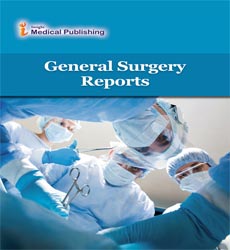Emergency General Surgery: Trends in Trauma and Acute Care
*Corresponding author:
Ghazali Ehsan,
Department of Medical and Surgical Sciences, University of Catanzaro “Magna Græcia”, 88100 Catanzaro, Italy,
E-mail: Ehsan.ghaza@uniupo.it
Received date: February 03, 2025, Manuscript No. ipgsr-25-20675; Editor assigned date: February 05, 2025, PreQC No. ipgsr-25-20675 (PQ); Reviewed date: February 10, 2025, QC No. ipgsr-25-20675; Revised date: February 17, 2025, Manuscript No. ipgsr-25-20675 (R); Published date: February 24, 2025
Citation: Ehsan G (2025) Emergency General Surgery: Trends in Trauma and Acute Care. Gen Surg Rep Vol.09.1:174.
Introduction
Emergency general surgery encompasses a broad spectrum of urgent and life-threatening surgical conditions that require prompt evaluation, decision-making and intervention. This domain includes trauma management, acute abdominal emergencies, perforated viscus, gastrointestinal bleeding, bowel obstruction and severe soft tissue infections, among others. The urgency of these conditions necessitates rapid diagnosis and coordinated multidisciplinary care to minimize morbidity and mortality. Over recent decades, advances in surgical techniques, critical care management, imaging modalities and perioperative support have transformed outcomes in emergency general surgery [1].
Description
Trauma continues to be a leading cause of mortality and morbidity worldwide, particularly in young adults. Effective management requires rapid assessment using established protocols, such as Advanced Trauma Life Support (ATLS), to identify life-threatening injuries and prioritize interventions. Diagnostic modalities, including Focused Assessment with Sonography in Trauma (FAST), Computed Tomography (CT) and angiography, have revolutionized trauma evaluation by enabling rapid, accurate and non-invasive assessment of internal injuries. Case studies demonstrate that early imaging allows timely surgical or endovascular intervention, reducing the risk of hemorrhagic shock and organ failure [2]. Damage control surgery has emerged as a cornerstone in the management of severely injured patients. This strategy involves performing limited, life-saving interventions initially, followed by resuscitation in the intensive care unit and subsequent definitive repair once the patient stabilizes. Techniques such as temporary abdominal closure, vascular shunting and staged bowel resections exemplify this approach. Clinical evidence indicates that damage control surgery reduces mortality in polytrauma patients, minimizes the physiological burden of prolonged operative procedures and improves survival in critically ill individuals with severe injuries or coagulopathy.
In addition to trauma, acute surgical emergencies such as bowel obstruction, perforated peptic ulcer, acute appendicitis and severe cholecystitis require timely operative intervention. Minimally invasive techniques, particularly laparoscopic surgery, have become increasingly utilized in emergency settings. Laparoscopy offers diagnostic and therapeutic benefits, including reduced postoperative pain, shorter hospitalization, decreased wound complications and faster return to normal activity. Case reports illustrate that laparoscopic management of acute appendicitis or cholecystitis is safe and effective, even in hemodynamically stable patients with severe inflammation. Acute care surgery models have significantly improved efficiency in emergency surgical services. These models involve dedicated surgical teams, streamlined triage protocols and rapid access to operating rooms. By consolidating expertise and resources, acute care surgery units reduce time to intervention, optimize patient outcomes and decrease hospital length of stay.
Evidence indicates that institutions implementing acute care surgery services experience lower mortality rates, improved postoperative recovery and enhanced patient satisfaction, highlighting the importance of structured systems in emergency surgical care. Trauma care has been further enhanced by the integration of interventional radiology. Endovascular techniques, including embolization, stenting and percutaneous drainage, provide minimally invasive alternatives to open surgery for controlling hemorrhage, managing visceral injuries, or addressing vascular complications. These interventions reduce operative time, blood loss and postoperative morbidity, particularly in patients with high surgical risk or complex comorbidities. Case studies demonstrate that hybrid approaches, combining surgical and endovascular techniques, optimize outcomes in polytrauma and complex abdominal injuries.
Conclusion
Emergency general surgery remains a dynamic and challenging field, encompassing trauma care and acute surgical interventions for a wide spectrum of conditions. Advances in minimally invasive techniques, imaging modalities, damage control surgery and acute care models have significantly improved patient outcomes, reducing morbidity, mortality and recovery times. Laparoscopic and robotic-assisted interventions, combined with endovascular and hybrid approaches, provide safe and effective options for managing complex and high-risk patients. Critical care integration, prehospital systems and structured acute care surgery units enhance rapid assessment, timely intervention and coordinated care, optimizing patient outcomes. Emerging technologies, including telemedicine, artificial intelligence and advanced imaging, are further shaping the future of emergency general surgery by improving diagnostic accuracy, operative planning and patient monitoring. Ongoing education, simulation-based training and multidisciplinary collaboration ensure that surgeons remain proficient in evolving techniques, maintaining high standards of patient care. Challenges such as high patient acuity, comorbidities, resource limitations and postoperative complications remain, necessitating individualized management strategies, meticulous operative planning and evidence-based perioperative care. By combining technological innovations, structured acute care systems and patient-centered approaches, emergency general surgery continues to advance, improving survival, functional recovery and quality of life for patients facing urgent surgical conditions.
Acknowledgement
None.
Conflict of Interest
None.
Reference
- Montorsi M, Torzilli G, Fumagalli U, Bona S, Rostai R (1994) Percutaneous alcohol sclerotherapy of simple hepatic cysts. Results from a multicentre survey in Italy. HPB Surg 8: 89-94.
Google Scholar Cross Ref Indexed at
- Regev A, Reddy KR, Berho M, Sleeman D, Levi JU (2001) Large cystic lesions of the liver in adults: A 15-year experience in a tertiary center. J Am Coll Surg 193: 36-45.
Open Access Journals
- Aquaculture & Veterinary Science
- Chemistry & Chemical Sciences
- Clinical Sciences
- Engineering
- General Science
- Genetics & Molecular Biology
- Health Care & Nursing
- Immunology & Microbiology
- Materials Science
- Mathematics & Physics
- Medical Sciences
- Neurology & Psychiatry
- Oncology & Cancer Science
- Pharmaceutical Sciences
